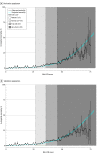Adaptation of the Risk Analysis Index for Frailty Assessment Using Diagnostic Codes
- PMID: 38787554
- PMCID: PMC11127118
- DOI: 10.1001/jamanetworkopen.2024.13166
Adaptation of the Risk Analysis Index for Frailty Assessment Using Diagnostic Codes
Abstract
Importance: Frailty is associated with adverse outcomes after even minor physiologic stressors. The validated Risk Analysis Index (RAI) quantifies frailty; however, existing methods limit application to in-person interview (clinical RAI) and quality improvement datasets (administrative RAI).
Objective: To expand the utility of the RAI utility to available International Classification of Diseases, Tenth Revision, Clinical Modification (ICD-10-CM) administrative data, using the National Inpatient Sample (NIS).
Design, setting, and participants: RAI parameters were systematically adapted to ICD-10-CM codes (RAI-ICD) and were derived (NIS 2019) and validated (NIS 2020). The primary analysis included survey-weighed discharge data among adults undergoing major surgical procedures. Additional external validation occurred by including all operative and nonoperative hospitalizations in the NIS (2020) and in a multihospital health care system (UPMC, 2021-2022). Data analysis was conducted from January to May 2023.
Exposures: RAI parameters and in-hospital mortality.
Main outcomes and measures: The association of RAI parameters with in-hospital mortality was calculated and weighted using logistic regression, generating an integerized RAI-ICD score. After initial validation, thresholds defining categories of frailty were selected by a full complement of test statistics. Rates of elective admission, length of stay, hospital charges, and in-hospital mortality were compared across frailty categories. C statistics estimated model discrimination.
Results: RAI-ICD parameters were weighted in the 9 548 206 patients who were hospitalized (mean [SE] age, 55.4 (0.1) years; 3 742 330 male [weighted percentage, 39.2%] and 5 804 431 female [weighted percentage, 60.8%]), modeling in-hospital mortality (2.1%; 95% CI, 2.1%-2.2%) with excellent derivation discrimination (C statistic, 0.810; 95% CI, 0.808-0.813). The 11 RAI-ICD parameters were adapted to 323 ICD-10-CM codes. The operative validation population of 8 113 950 patients (mean [SE] age, 54.4 (0.1) years; 3 148 273 male [weighted percentage, 38.8%] and 4 965 737 female [weighted percentage, 61.2%]; in-hospital mortality, 2.5% [95% CI, 2.4%-2.5%]) mirrored the derivation population. In validation, the weighted and integerized RAI-ICD yielded good to excellent discrimination in the NIS operative sample (C statistic, 0.784; 95% CI, 0.782-0.786), NIS operative and nonoperative sample (C statistic, 0.778; 95% CI, 0.777-0.779), and the UPMC operative and nonoperative sample (C statistic, 0.860; 95% CI, 0.857-0.862). Thresholds defining robust (RAI-ICD <27), normal (RAI-ICD, 27-35), frail (RAI-ICD, 36-45), and very frail (RAI-ICD >45) strata of frailty maximized precision (F1 = 0.33) and sensitivity and specificity (Matthews correlation coefficient = 0.26). Adverse outcomes increased with increasing frailty.
Conclusion and relevance: In this cohort study of hospitalized adults, the RAI-ICD was rigorously adapted, derived, and validated. These findings suggest that the RAI-ICD can extend the quantification of frailty to inpatient adult ICD-10-CM-coded patient care datasets.
Conflict of interest statement
Figures

Similar articles
-
Predicting the prevalence and outcomes of frailty through ICD-10 in older adults: experiences from a regional hospital in Taiwan.Intern Med J. 2025 Jul;55(7):1120-1126. doi: 10.1111/imj.70069. Epub 2025 Apr 11. Intern Med J. 2025. PMID: 40214128
-
Elective THA for Indications Other Than Osteoarthritis Is Associated With Increased Cost and Resource Use: A Medicare Database Study of 135,194 Claims.Clin Orthop Relat Res. 2024 Jul 1;482(7):1159-1170. doi: 10.1097/CORR.0000000000002922. Epub 2023 Nov 24. Clin Orthop Relat Res. 2024. PMID: 38011034 Free PMC article.
-
Risk Analysis Index for Estimation of 30-Day Postoperative Mortality in Hip Fractures.JAMA Netw Open. 2025 May 1;8(5):e2512689. doi: 10.1001/jamanetworkopen.2025.12689. JAMA Netw Open. 2025. PMID: 40440016 Free PMC article.
-
[Volume and health outcomes: evidence from systematic reviews and from evaluation of Italian hospital data].Epidemiol Prev. 2013 Mar-Jun;37(2-3 Suppl 2):1-100. Epidemiol Prev. 2013. PMID: 23851286 Italian.
-
Comprehensive Geriatric Assessment for community-dwelling, high-risk, frail, older people.Cochrane Database Syst Rev. 2022 May 6;5(5):CD012705. doi: 10.1002/14651858.CD012705.pub2. Cochrane Database Syst Rev. 2022. PMID: 35521829 Free PMC article.
Cited by
-
Comparing Hospital-Free Days by Frailty Status for Patients Undergoing Surgical Intervention for Cardiovascular Disease.J Am Coll Surg. 2025 Sep 1;241(3):438-447. doi: 10.1097/XCS.0000000000001408. Epub 2025 Aug 14. J Am Coll Surg. 2025. PMID: 40226927
-
Assessment of Racial Bias within the Risk Analysis Index of Frailty.Ann Surg Open. 2024 Sep 25;5(4):e490. doi: 10.1097/AS9.0000000000000490. eCollection 2024 Dec. Ann Surg Open. 2024. PMID: 39711679 Free PMC article.
-
Predictive Value of Geriatric Nutritional Risk Index and Risk Analysis Index for Post-operative Outcomes in Spine Surgery Patients: A Comprehensive Analysis.Global Spine J. 2025 Aug 28:21925682251375072. doi: 10.1177/21925682251375072. Online ahead of print. Global Spine J. 2025. PMID: 40876846 Free PMC article.
-
The Intersection between Frailty, Diabetes, and Hypertension: The Critical Role of Community Geriatricians and Pharmacists in Deprescribing.J Pers Med. 2024 Aug 30;14(9):924. doi: 10.3390/jpm14090924. J Pers Med. 2024. PMID: 39338179 Free PMC article. Review.
-
The Surgical Pause: The Importance of Measuring Frailty and Taking Action to Address Identified Frailty.Jt Comm J Qual Patient Saf. 2025 Mar;51(3):167-177. doi: 10.1016/j.jcjq.2024.11.011. Epub 2024 Nov 22. Jt Comm J Qual Patient Saf. 2025. PMID: 39799070

